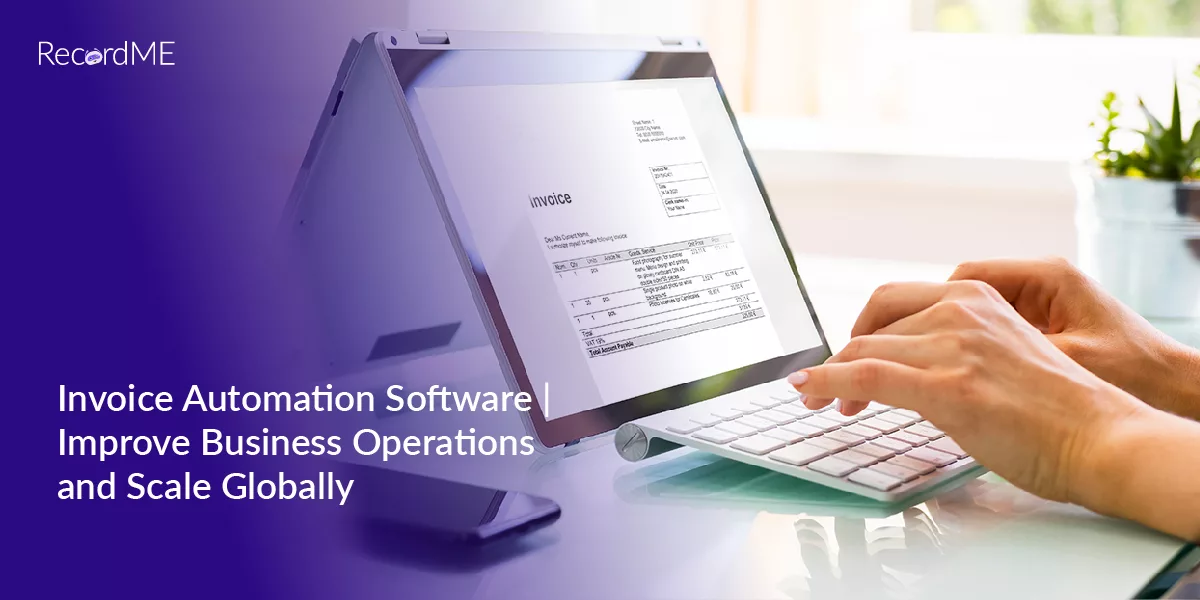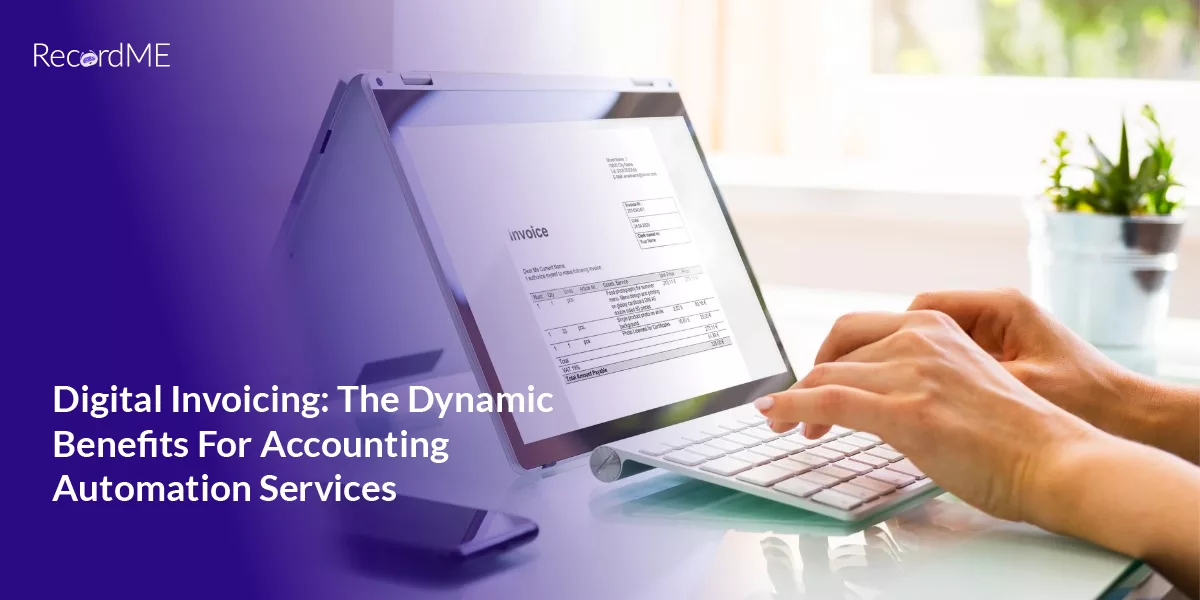Automated Invoice System – Revolutionises the Accounting Industry

In This Post
Do you ever get lost in invoices attempting to match receipts and purchase orders?
Manual invoice processing, payments, inaccurate entries, and lost receipts may be a nightmare for small firms without an accounts payable team. Invoicing is a crucial part of running a business. It’s a necessary but also one of the most challenging and time-consuming tasks.
Fortunately, an automated invoice system exists! This technology automates billing management. Artificial intelligence algorithms speed up, improve, and reduce errors in invoicing.
This article will discuss functionality and methods for implementing an automated invoice system.
Automated Invoice System – A Comprehensive Overview
E-invoicing, or automated invoice processing, uses on-premise or SaaS software to handle each step of the payment workflow digitally.
Automated invoicing software extracts and integrates invoice data with the firm ERP system to help AP teams manage paper invoices. In addition, it uses three-way matching to double-check that each invoice corresponds to the appropriate Purchase Order (PO) and receiving report. After that, it alerts the appropriate approvers or authorisation and then sends the invoice to finance for payment once it has been approved.
The automated invoice system accelerates and drops the per-invoice cost by reducing manual data entry. According to Ardent Partners, top companies utilising AP automation systems reduced their invoice processing costs by up to 80% and faster processing times by up to 74%.
How Does an Automated Invoice System Work?
So, how precisely does an automated invoice system function? Let’s divide it into its essential components:
-
Invoice Capture
This is where the invoice will officially become a part of your company’s finances. The traditional approach of manually entering billing data into the system is time-consuming and error-prone, especially for large invoice quantities. Invoice automation software facilitates this process by automatically collecting payment data from multiple sources, both paper and digital invoices included.
The automated invoice system scans paper invoices using OCR to retrieve invoice date, amount, and line item information. For electronic invoices, the software may extract the relevant information with little user input.
-
Data Extraction and Validation
The invoice automation solution then takes the gathered invoice details and extracts the necessary data. Common elements include the company name of the supplier, the payment request number, the date, and the products listed on the invoice. After data is extracted, it is checked against pre-existing business records like invoices and receipts. This verification is essential for avoiding double payments, checking that the billed amount aligns with the purchase order, and verifying that the products or services were received.
-
Invoice Approval
Once the invoice has been checked and verified, it is sent for final approval. In an invoice automation system, the approval process is governed by rules and procedures, resulting in uniformity and efficiency. A manager may need to approve bills over a specific limit, whereas smaller ones may be accepted automatically. An advanced automated invoice system can instantly match receipts, purchase orders, and payments. If everything checks out, the bill can be paid without any human interaction.
-
Record Keeping and Reporting
Even after payment has been made, there will still be an invoice record. The automated invoice software stores this data as an audit trail. Historical data is helpful for inspecting and analysing the company’s spending, supplier performance, and process efficiency. The system may provide invoice delays, supplier payment schedules, and more.
An automated invoice system is valuable because it streamlines and expedites many of the receipt processes involved in paying vendor bills. This lowers human errors, invoice processing time, and resources, letting businesses focus on their core operations.

How an Automated Invoice System Relieves Accountants of Routine Tasks?
The varied responsibilities of an accountant’s employment can sometimes be challenging to keep together. Some of these problems can be solved by using an automated invoice system, which also frees up auditors for more strategic work.
Let’s talk about some of the things that companies can automate right now.
-
Accounts Receivable & Payable (AP/AR)
Here’s a quick overview for people who are starting to understand accounting and bookkeeping:
- When a company owes suppliers for any purchases made with credit, it is known as accounts payable or AP. Bills, rent, and other expenses are a few examples.
- Accounts Receivable (AR) is the money owed by clients who have been given credit terms to make purchases from your business.
Both directly affect the company’s operations. Additionally, both are required to create the financial statement and calculate your business cash flow.
Inadequate accounts payable management can lead to costly fines and a damaged reputation with suppliers. However, businesses that neglect to handle AR face the possibility of going bankrupt.
-
Payroll
Companies are paying an accountant or an HR manager to handle payroll. This person most likely spends a lot of time going through the hours employees work, tax records, and their rates. Activities like these are the ones that can be automated.
An automated invoice system assists a company whether they’re managing hourly freelancers or employees with set pay rates:
- Integrate with time-tracking software to determine pay
- Process payroll taxes and produce filings automatically
- Pay employees immediately from their bank accounts
The American Payroll Association claims that because automation lowers payroll processing costs by 80%, the company can reap significant benefits.
-
Expense Management
It is never enjoyable to have to chase down coworkers and collaborators to get their receipts. The collection, transmission, and administration of expenses are all made easier with an automated invoice system.
All employees need to do is take a photo of their receipt. Following that, the data is extracted by the system and sent to your accounting program.
Interesting fact: According to a survey, 85% of respondents misrepresented an expense report to increase their refunds.
-
Bookkeeping, Income Taxes, and Monthly Financing
Monthly financial closing, like tax season, can be difficult and time-consuming for businesses. According to a recent survey, 90% of participants felt pressured to finish their monthly finances on time.
As everyone runs to collect everything, the number of things that need to be done increases. Typical problems consist of the following:
- Recognising and fixing errors
- Stay up-to-date with tax hikes
- Transferring information between apps
- Finding missing receipts and invoices
- Eliminating redundant files and objects
- Recognising unidentified payments
Businesses can use automation technologies to change the way they handle bookkeeping. Therefore, invoices for a firm might be automatically duplicated and saved on Google Drive so they are easily accessible throughout tax season.
Automated Invoice System – Why Finance Leaders Are Making the Switch
With invoice automation solutions, professionals in finance and accounting maintain their competitive advantage. By automating the accounts payable procedures and establishing a robotic invoice processing environment, they are able to get rid of these problems in addition to many more.
Businesses that use automated invoicing systems are seeing a decrease in the amount of paper bills they receive, along with faster invoice approval times.
The rise in cloud-based AP automation solutions is the most noteworthy development. Cloud invoice automation systems are “the most adaptable and accessible options available” because they are “increasingly flexible, dynamic, and affordable.”
Using intelligent technology in an automated invoice system is another noteworthy trend. Leaders in finance are now more aware than ever of the innovative technologies available. Thus, Optical Character Recognition (OCR), Machine Learning (ML), Artificial Intelligence (AI), and smart data extraction are a few of the technologies that are highlighted.
Automate Your Invoice System with RecordMe
Are you tired of manually sending invoices every day? By eliminating error-prone and inefficient manual processes, RecordMe’s invoice processing service provides a complete solution for businesses and individuals. For effective and accurate financial management, an automated invoice system gives a company an edge.
RecordMe, an automated accounting platform, delivers businesses financial stability and a competitive edge by boosting financial management efficiency, accuracy, and security. It handles business cash flow and data-entry issues. With a good cash flow and strategy, no one can stop a business from growing.
Are you still unsure about how automation might help you thrive in the modern digital world? Contact Us!



